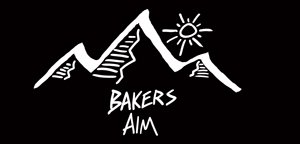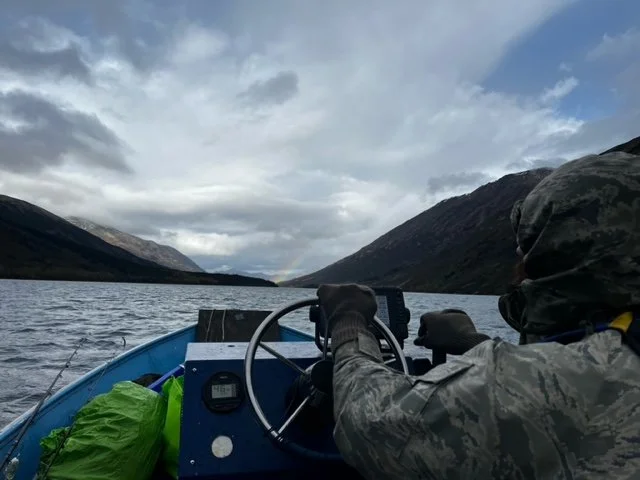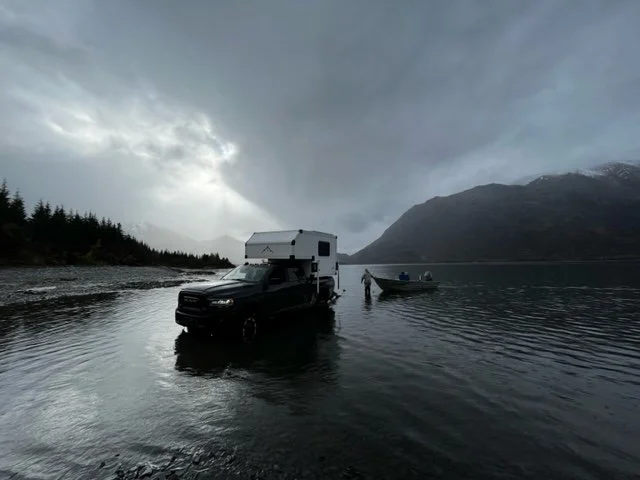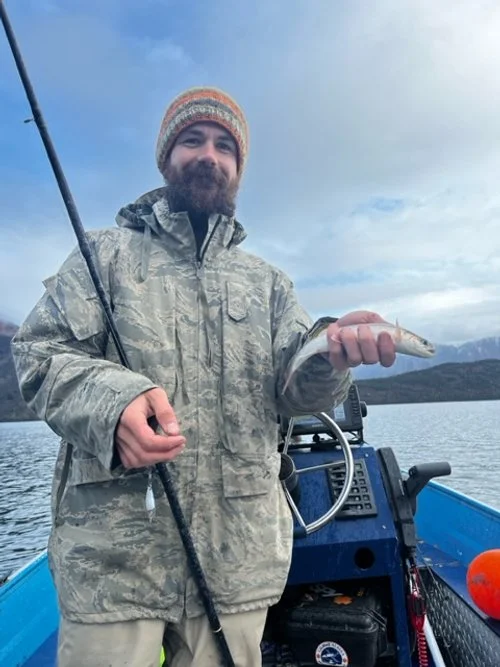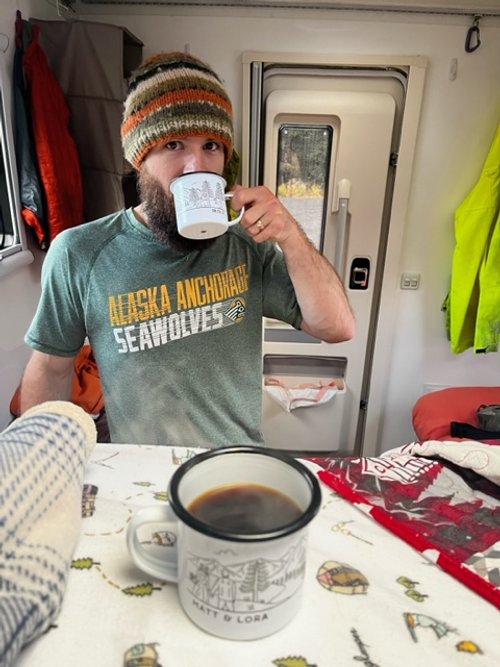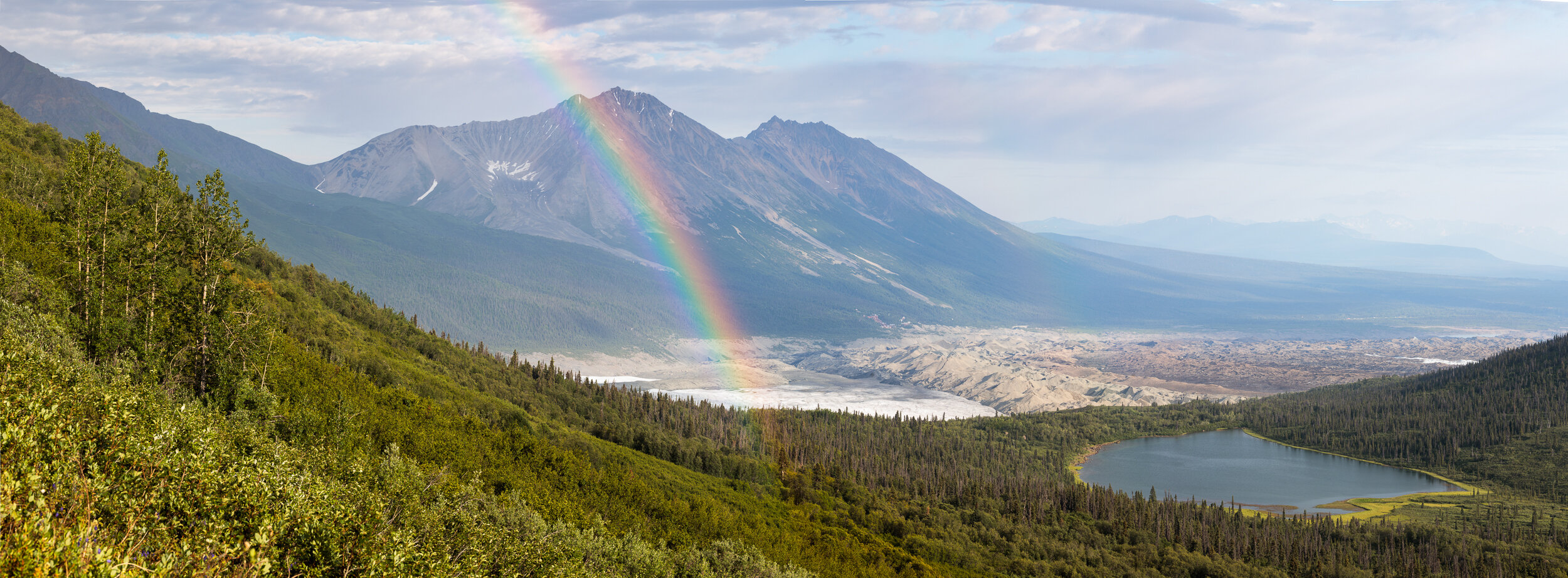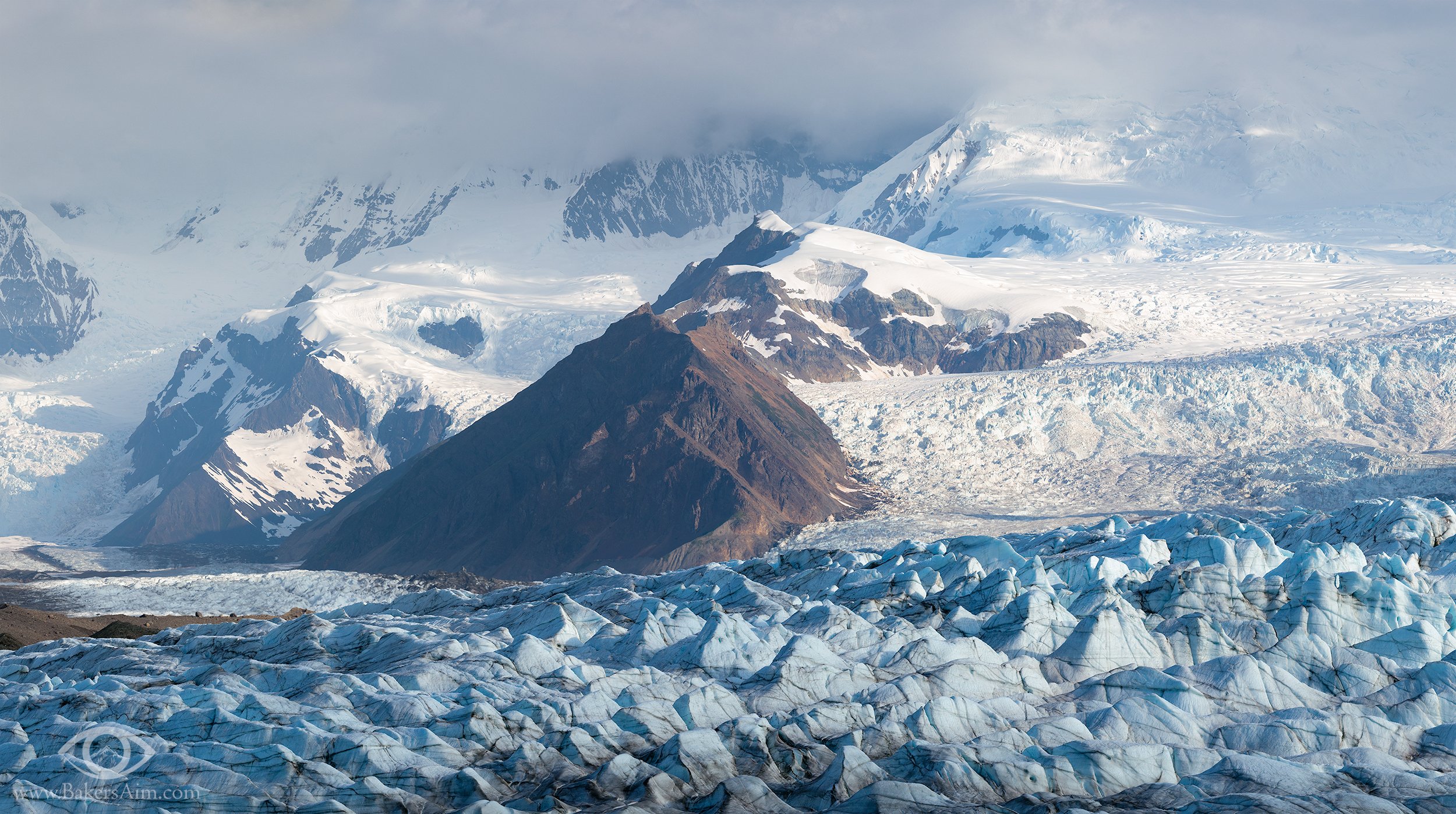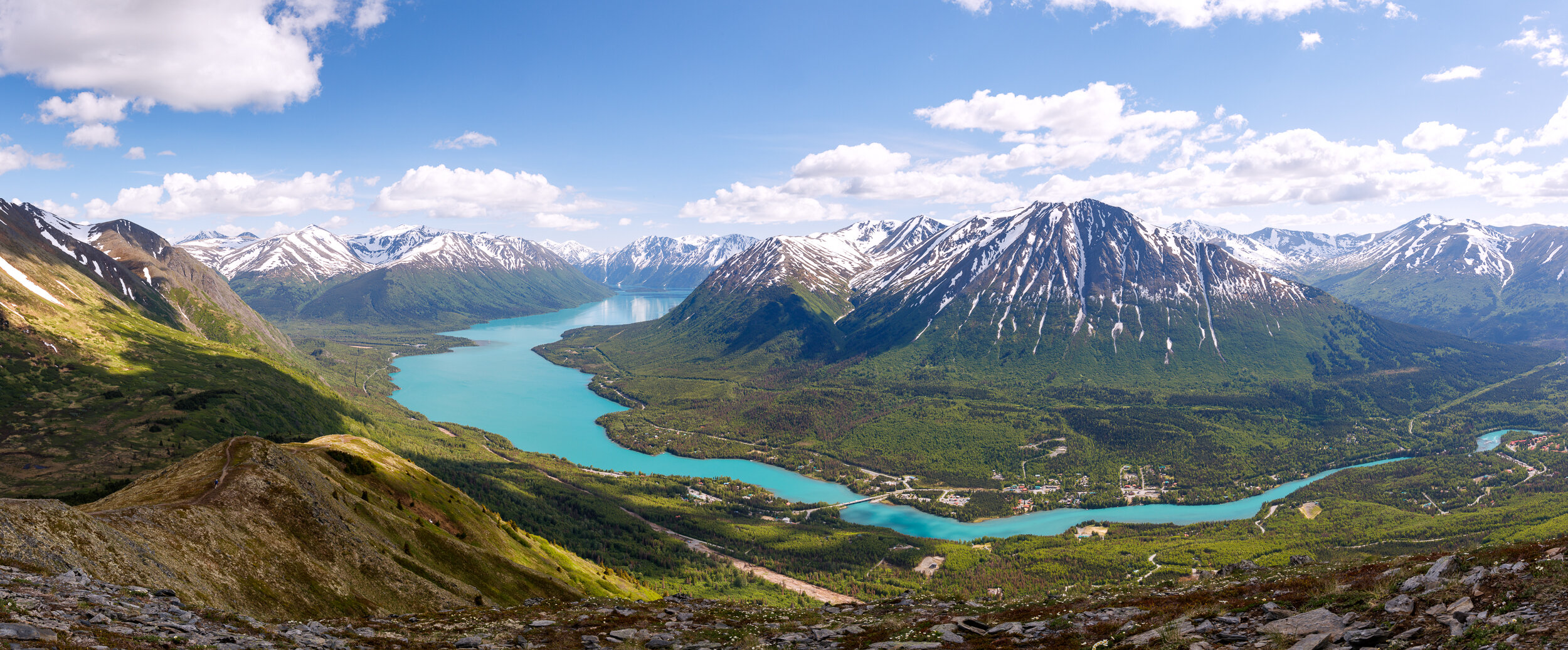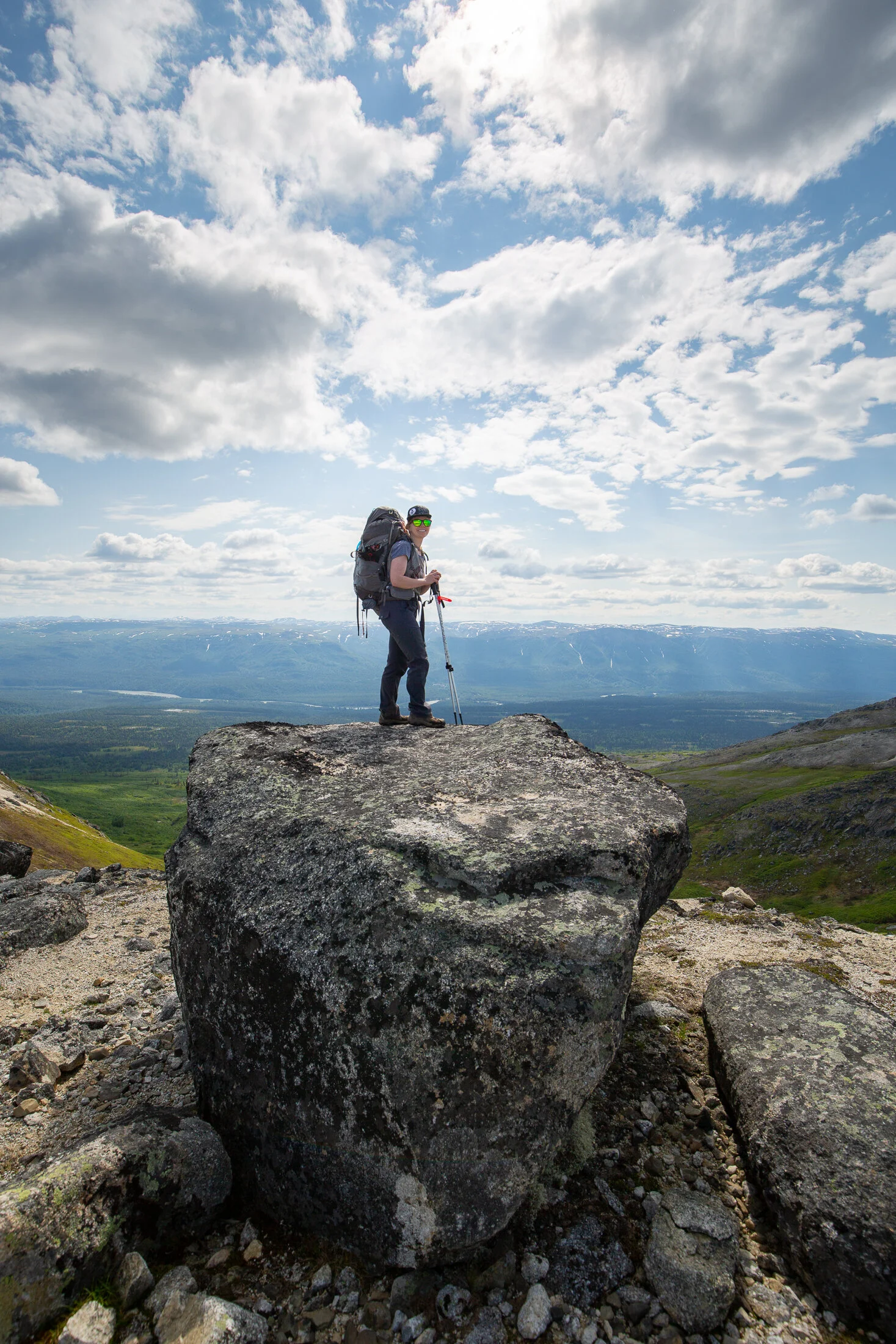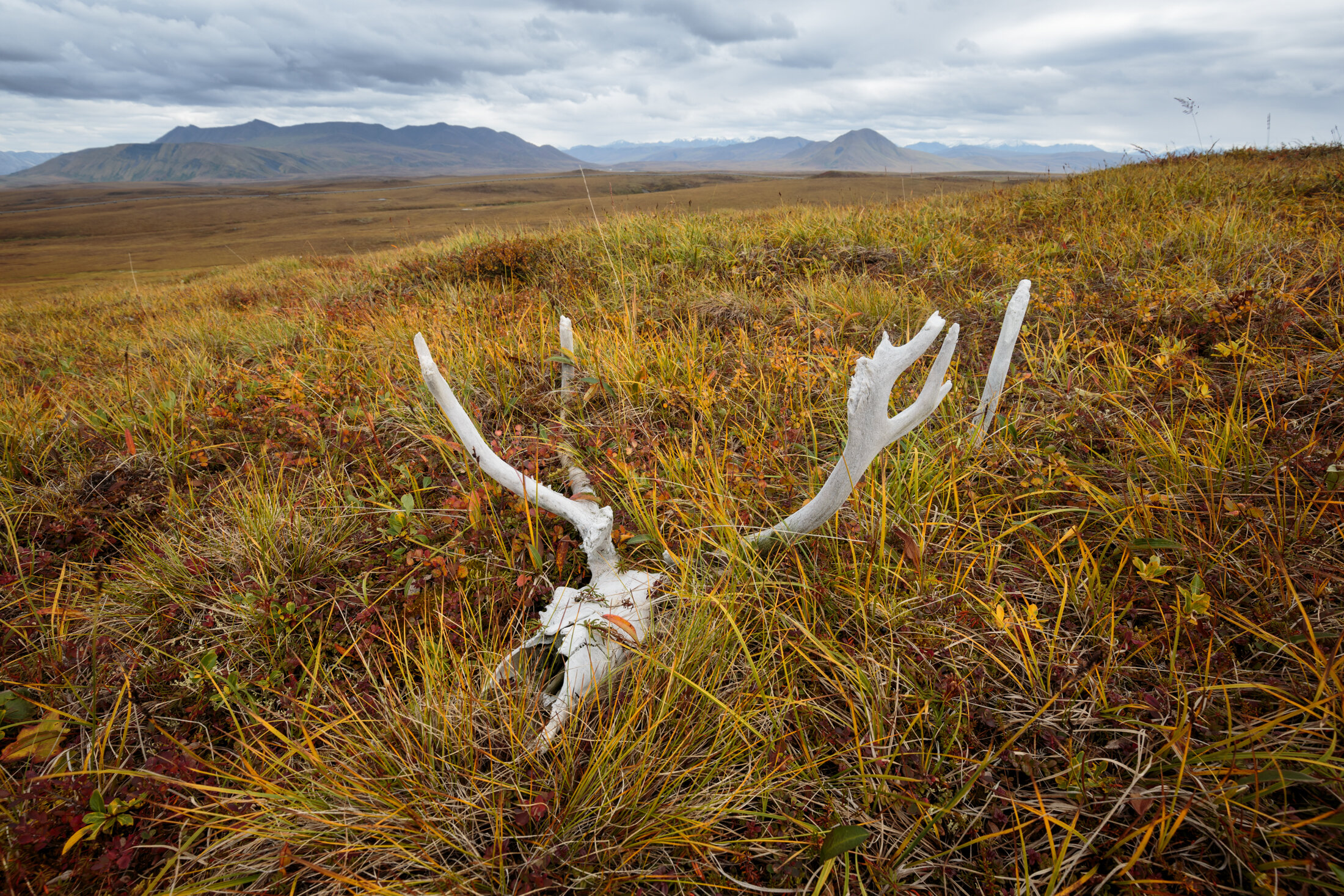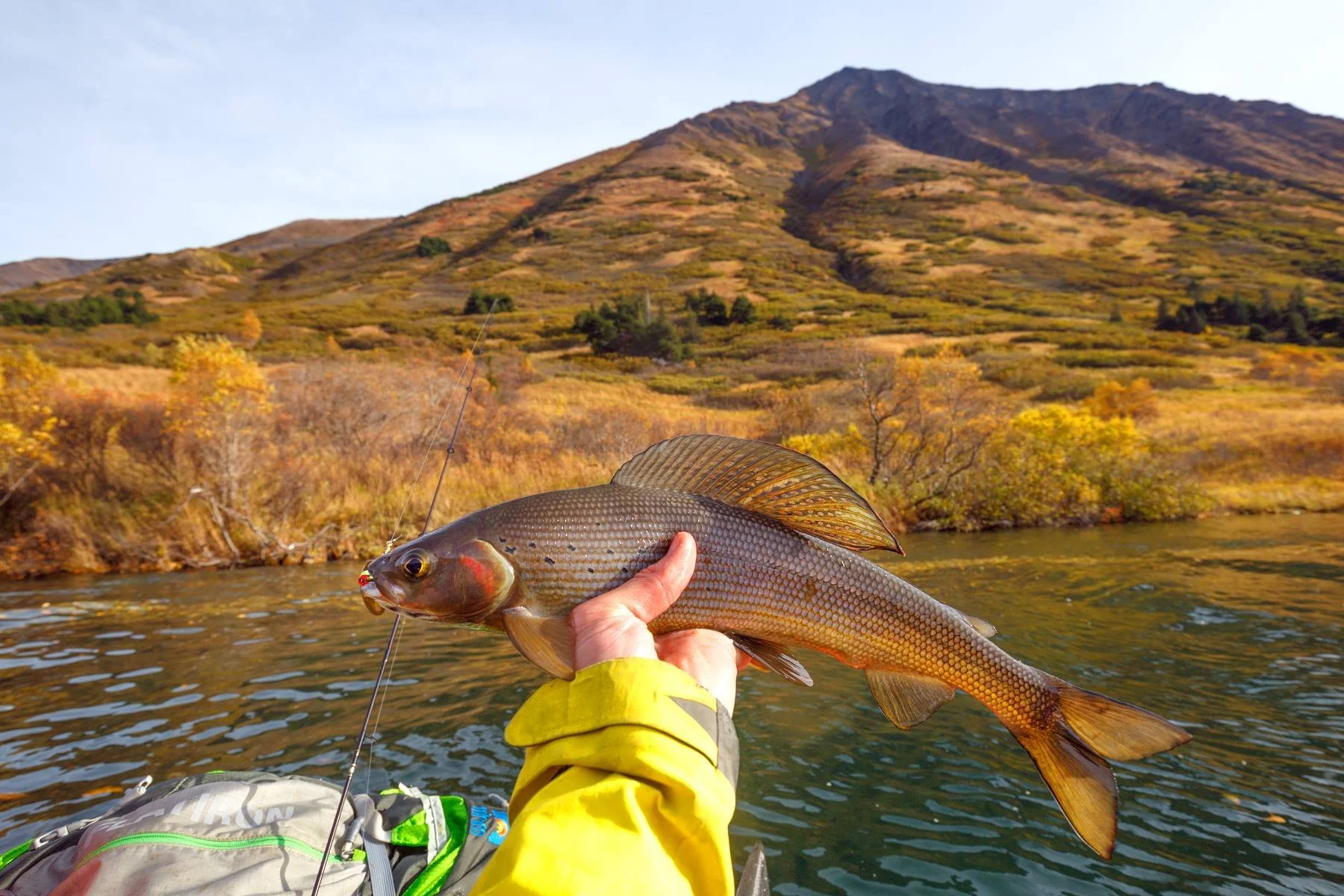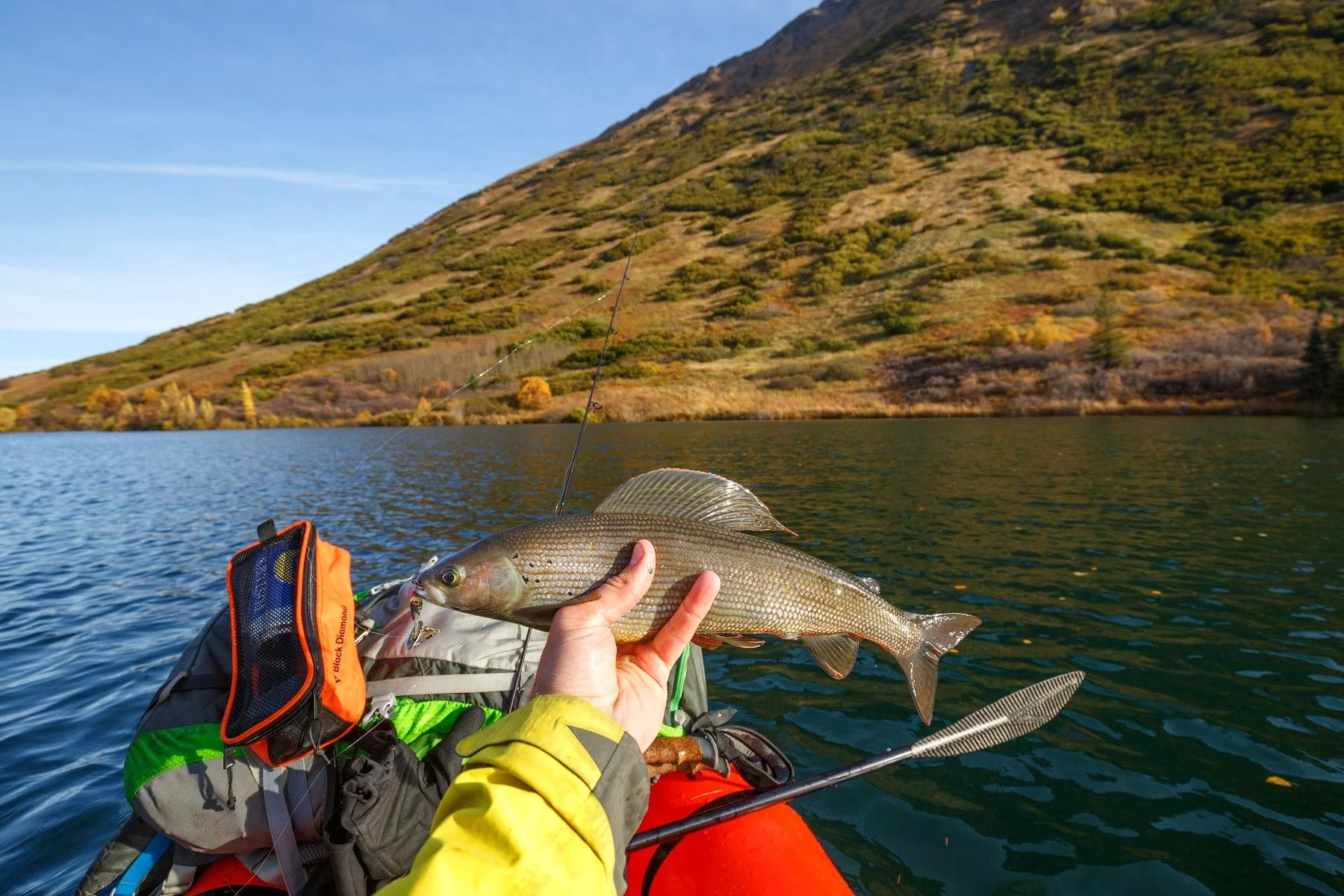Trip Report:
Who: Lora, Eveline, Matt
What: Checking shrimp pots, prospecting, and retrieving some skulls I wanted cleaned.
When: May 4-5th 2024
Where: Whittier Alaska
Why: Replenish our dwindling supply of shrimp, strike it rich finding gold (not really)



Follow up to my last entry. We made it out to Whittier again to check the shrimp pots. Lora and I drove all the way yesterday with baby Eveline and we were planning on checking them together but unfortunately the weather was not safe for our small boat. I checked the forecast before leaving home, however when we arrived the wind was howling out of the east with driving rain. We made the safe decision to wait until tomorrow. No amount of shrimp is worth capsizing a boat over.
Checking the pots a day later meant I would be doing it alone. Lora and Eveline had a date to meet up with another mom and baby. This time the weather in Whittier was perfect, Glassy water with a light misting rain. I scooted out to the shrimping grounds and to my delight there were a few gallons of shrimp waiting. Pulling the pots with the buoy can be laborious, but it is a simple and inexpensive solution.
When I set the pots on my last trip I put two Pine Marten heads in the bait jars. My hope was that the sea lice and shrimp would eat the flesh and leave me with a clean skull. My plan worked better than I could have imagined. The skulls were 100% picked clean. They looked professionally done.
The Marten heads came from my winter trap line. I take the ethics of my trapping very seriously. If I am going to harvest an animal I want to use the entire thing. The fur is being used for garments which I may write about later. I originally planned on using the entire Marten (not just the head) to bait the pots, but instead I donated the Marten bodies to a study being done by the University of Alaska. The researchers did not have a use for the heads, so I kept them hoping to make an interesting memento from my trapline.
After taking care of the shrimp, I headed over to the same cove my family and I went to on our last outing. I stopped on the beach for a quick lunch of Ramen noodles – not my usual choice but it is quick and warms me up. This time I remembered my gold pan and I took some time to prospect the small bedrock creek that poured onto the beach. I cleaned out some small cracks and panned about a half dozen spots that looked promising. No luck on gold, but just the act of prospecting is entertaining enough to keep me trying.
I eventually made it home. I was stuck for over an hour behind a train moving through the Whittier tunnel. Lora had a tough day with the baby, so I volunteered to make some shrimp for dinner. As I shelled them Lora dug out some powdered coconut from our pantry and suggested breading the shrimp with it. I fried them in a shallow pan of oil, and they turned out wonderful. The shrimp have a natural sweetness to them when fresh that amplifies the taste of the coconut.
While cooking I thought of my friend Nathan who recently passed away. He came to visit from Michigan last year. He went on several shrimping trips with me. He hates seafood but I brought him along for the ride anyway to see the beautiful nature of Prince William sound. I think he appreciated it. He even tried some of the shrimp which he described as, “not terrible” which I felt like was a compliment coming from him!

Trip Report:
Who: Lora, Eveline, Matt
What: Shrimping and exploring in our small skiff
When: May 2024
Where: Whittier Alaska
Why: Replenish our dwindling supply of shrimp, explore with the new baby, and enjoy family time.
Lora, Eveline, and I travelled to the town of Whittier for our first boat outing of the year. Lora took a day off from work and suggested we go set up our shrimp pots and do some exploring of Prince William sound. We recently ate our last package of shrimp from the freezer and needed to replenish our supply.
The forecast in Whittier showed favorable winds which was great news. Our boat is small, so we must be smart when we take it out. The only other weather obstacle was rain and cold, which is normally not a problem for Lora and I. However, we now have four-month-old baby Eveline with us which changes things. When we first arrived in Whittier it was pouring rain and 40 degrees. Eveline was already fussy from being off her usual routine – and dealing with cold rain in an open skiff made me worry. I prepped and organized the boat while Lora breastfed Eveline in the warm truck. I didn’t mind the delay because it gave the rain a chance to clear up. I have learned having a kid is an opportunity to practice being patient.
To my surprise the rain lightened by the time Eveline was done feeding and we began to launch the boat. In the past I dreaded backing the boat into the water because of how terrible I was at reversing a trailer. But with time and plenty of practice I am now confident in my abilities. Now the only problem to deal with in Whittier now were minor annoyances; chief among them were all the fees. A $22 fee to get through the tunnel, $25 fee to launch the boat, and a $15 fee to park for a few hours. Add a tank of gas to the mix and it begins to be an expensive trip. Having to break out my wallet this many times I began to wonder if all of this was worth it.
After a trouble-free launch the boat started without hesitation. It sat all winter, yet the motor ran smooth and quietly. We scooted out of the harbor and were soon on our way to our shrimping grounds. The ocean had a slight chop to it, but it made for a pleasant ride. The rain had turned into a light mist and my worries about baby Eveline dissipated. Lora did an excellent job making sure she was tucked away warm and snug in her car seat. She even managed to put her in an infant life vest and then wrapped her in a rain jacket. Eveline was certainly the warmest on board.
Once we arrived at our fishing spot, I took stock of all the gear needed to rig up our shrimp pots. I had to go through a mental checklist to try to remember where each rope went. Our trap setup is more complicated than most because we pull our pots with the buoy and motor which requires additional parts. There is no room on our boat for a fancy pot puller. Soon I had everything figured out and I began to bait the pots. I filled the bait chambers with pellets doused with herring oil and as a bonus I tossed in two fleshy marten skulls from trapping this winter. I am hoping the sea lice and shrimp will eat them to the bone and I will be left with a clean specimen skull. Before throwing the pots in the water I asked Lora what the depth finder read, “530 feet!” she replied “Perfect” I said as I tossed the pots and began feeding the rope over the gunnel.
Our shrimp pots were set and now we had time for a little exploration of the nearby cove. Lora wanted to feed Evie again and stop for lunch, so we went looking for a calm place to beach the boat. On the way we passed by a large mooring raft where there are always sea lions piled on top of one another. We passed within 200 yards of the pile of animals when suddenly one lunged into the sea and performed a series of leaping dives toward our boat roaring each time it surfaced. It was clearly heading towards us and if we had stuck around there was a possibility it would have come after our boat. I veered the boat away from its course and headed further up the cove. Lora and I looked at each other in disbelief about what had happened. We agreed that it was bizarre how aggressively that animal was pursuing our little boat.
After outrunning the angry sea lion, we found a small cove to moor in. It had three freshwater streams that could be seen pouring out from the valley ahead. The three streams converged on the beach and drained into the cove where we anchored. The water had a hazy appearance where freshwater mixed with salt water. The shoreline was covered in a short kelp-like seaweed called popweed that makes a crackling sound like bubble wrap when stepped on. The flanks of the cove were steep and cliffy. The slopes above were covered in mountain hemlock trees that were draped in a fine green moss. They stretched vertically into the sky marching upward towards the mountains until disappearing in cloud. Above the rim of the cove there was still a substantial amount of snow; at least 3 feet. But down on the beach there were signs of spring with fresh green grasses beginning to sprout. Bears are drawn to these fresh grasses as it is a reliable source of calories during the scarcity of spring; I’ve also heard the fiber and roughage helps them clear their 'bowel plug' from hibernation. I’m not sure which story is true, but I do know hunters pay close attention to areas like these when seeking coastal black bear.
Soon after disembarking Lora took the opportunity to feed Evie who had been bundled and sleeping peacefully. Lora put a camping pad down on the rocky shore and nestled in with the baby. Despite the overcast gray weather, the beach had a warmth to it. Perhaps it was more a matter of perspective as being on the boat was always cold. As Evie fed, I fixed lora and I a small meal - leftover Japanese style salmon wrapped in some wheat tortillas. After making sure my wife was taken care of, I left her to finish feeding Evie while I explored the cove. I was surprised at how pristine nature was here. Not a single piece of litter or trash to be seen on the shoreline and I looked hard. It is hard to imagine this place was near the site of one of the worst oil spills in history.
I hiked up the steep cliffy banks and up into the hemlock forest. Out across the water I could hear the lazy groans of the aggressive sea lions. I turned my attention back to the forest where there was still a lot of snow but large patches of it had melted exposing the forest floor. The ground in these melted patches was surprisingly green. It looked like last summer’s growth was preserved under the snow; except the foliage was smooshed and flattened from the weight above. Small ferns and bright green mosses just waiting for the warmth to pick up where they left off.
I continued through the forest and post holed through the soft snow eventually making my way to a game trail that led back to the beach where Lora and Eveline were. Instead of going back to them I walked further up the cove to where the three streams were pouring out from the valley onto the beach. I had my waders on, so I hiked up a short section of stream and to my surprise it had a bedrock bottom which piqued my inner gold prospector’s curiosity. I knew that there were hard rock gold mining operations in Prince William sound long ago; so, I thought maybe there was a small amount of placer gold to be found? I knew it was wishful thinking, but maybe next time we take a break here I will bring a gold pan.
Lora had finished feeding Evie and we began to hike around the cove together. I took her up to the streams and Lora held Evie out at arm’s length showing her the various parts of nature she has probably never seen - I know Evie won’t remember any of this but perhaps trips like these will instill a foundation for an appreciation of the natural world. As we hiked back to the boat, we took some photos together and began to pack up. As we did, I noticed one of the cliffs had bands of quartz in it which again set off my prospectors’ curiosity. I took a small sample of the quartz and even convinced myself there might be a small seam of gold along the edge of the milky white rock; maybe someday I’ll crush up it up and pan it to see what’s in it.
We loaded up on the boat and shoved off from shore. The weather had improved considerably. The rain and wind had stopped and there were even hints of blue sky though the clouds. I opened the throttle on our Yamaha outboard and let the motor rev high; for some reason I thought this might be good for it after sitting all winter. As we jetted toward Whittier I wanted to make one final stop to the waterfall near the harbor. Last year I took my friend Nathan to this same spot, and we saw a mountain goat on the steep cliffs overlooking the ocean. I was hoping for a similar sight today. As we approached the waterfall, I spotted one almost immediately and shouted, 'Goat!' Lora saw it right away and I dug for my camera and telephoto lens. As I was snapping photos Lora spotted another two not far from this one. Before long we had counted 7 mountain goats!
The whole scene was beautiful and hard to describe in words. There were Impossibly steep cliffs rising straight out of the ocean with the water free-falling from the peaks above. Flocks of seabirds were perched in the cliffs above and their calls were deafening. The goats looked grizzled and weather-beaten after a long winter. They walked slowly and nibbled on grasses as they navigated the steep terrain. They did not look stressed by our presence below.
I have a great appreciation for the mountain goat after harvesting one last year. I feel inextricably linked to the animal. The hunt was one of the hardest things I had ever done and seeing the animals up close like this brought back clear memories. I slowly began turning the boat back towards the harbor. Suddenly I no longer felt annoyed by all the fees I had to pay to be here. In fact, it felt incredibly worth it and I am looking forward to my families next trip out.

Seward - Cooper Landing - Hope. June 21

Kesugi Ridge Trip Report. June 30th - July 3rd 2022
Denali Panorama as seen from our back country campsite
Lora and I both had a week off from work, so we decided to spend a few days backpacking in celebration of her brithday. Our goal for this trip was to hike and camp along Kesugi Ridge which is a trail system in Denali state park. It measures roughly 36 miles in length (which ended up being closer to 40 miles with our add-ons) We ended up taking two vehicles since the start and end of this trail are separated by considerable distance.
The start of our trip was delayed by rain and high winds. When the weather cleared, we drove north out of Anchorage to the town of Palmer and then further up into the mountains to camp at government peak campground near Hatcher pass. This quick overnight stop served a few purposes. It got us slightly closer to Denali state park, allowed us to wait out a nasty weather system, and gave us an opportunity for a good warm-up hike.
The weather at Hatchers Pass was better, but still a bit cold and rainy. We made the best of it and decided to stretch our legs and hike up to gold cord lake which to my surprise was still partially frozen over. I was hoping for some evening light to shoot photos, but the sky remained overcast and featureless. We then returned to the campsite, set up our tents, made some Caribou tacos, had some s’mores and went to bed.
Abandoned mining building on the hike up to gold cord lake
The next morning the weather had improved. It was sunny with blue skies and mild temperatures into the 50’s. We then drove further north up the parks highway to Byers Lake campground and left Lora’s Subaru in the parking lot. This would be the end point of our trip. She hopped in my Jeep and joined me as we drove an additional 17 miles north to ‘Little Coal Creek trailhead’ We loaded up our big backpacks and shared left-over espresso cupcake from her birthday before hitting the trail.
The hike was mostly uphill, but we still made great time. It was sunny and even felt hot at times but a cool breeze at our backs kept us going. Our conversations during the hike initially focused on the Pandemic. We mulled about a recent COVID outbreak at a salmon cannery but then remembered we were out hiking to take our minds off such things. We instead turned our attention to the peaks across the valley. They were enveloped in a haze that is common on warm days. Above them were thick puffy clouds which obscured the view of the biggest among them - Denali.
Eventually our hike leveled out and the steepness gave way to a large flat plateau of rolling tundra and short green grass. The easy terrain was a welcome break and the views continued to improve. We now had 360 degrees of mountains to enjoy. To our left there were snow flanked ridges and to our right in the distance were the foothills of Denali still enveloped in cloud. We saw lots of birds and ground squirrels, but no big game. One particularly interesting part about this hike were the several underground creeks we passed over. Rushing water could be heard deep under piles of talus and scree but not a drop of water could be seen from above. I wondered how many boulders I would have to move to find the source.
By the end of the day, we covered just shy of 8 miles before stopping for the evening. We could have easily kept going but saw another party of hikers in the distance and wanted to give them space. We set up camp and took a tundra nap. As we laid in the tundra a swarm of mosquitos descended upon us. The cool breeze from earlier in the day had died down and now the bugs were free to fly around and hunt. We were forced inside the tent. It felt odd to be getting ready for bed with the sun blazing overhead but it was already after 10 pm, and we had a full day of hiking ahead of us tomorrow. I fixed Lora and I a cup of hot cocoa and we snuggled in for the night.
The next morning, I was up early at 0345 to check what the sunrise would be like for photography. Sadly (or luckily?) it was overcast so I crawled back in my sleeping bag for a few more hours of snoozing. When we woke the sky had cleared and the sun was already blazing overhead. Lora let me play with my camera for an hour while she tore down camp. I usually make the meals and filter the water, so it is a fair split on camp labor.
While shooting photos I noticed my 70-200mm F4 lens was having issues. The images had an odd warp distortion I’ve never seen before. They were in focus, but something was off. I figured the lens must’ve taken a hard hit sometime during the hike. It was a shame because this lens was my landscape workhorse. Especially during this hike where many of the views are far-off.
Odd distortion in the foreground and background from my 70-200 lens. What a shame!
The rest of the morning was spent meandering through a boulder field on top of the plateau. It was fascinating seeing rocks the size of semi-trucks strewn about on top of a mountain. I found it hard to imagine what kind forces might have put them there. Lora scrambled to the top of one of the boulders and as I brought my camera out of my bag to snap a pic the lens somehow tumbled off from the front of the camera body. It dropped about three feet to the ground and made a sickening thud on a rock in front of me. My heart sank as I picked it off the ground and dusted it off. Thankfully only a small plastic piece behind the zoom ring cracked and after taking a few test shots the lens seemed to be unharmed. I reminded myself that these types of things happen occasionally, and I must accept that, but to have two instances in one trip is a little unsettling!
Lora on the boulder just after I dropped my lens!
In the afternoon we began to descend from the plateau. On the periphery of the cliffs there were fascinating slabs and spires of rock with waves carved in them from years of wind erosion. Once we reached the valley floor, we were in for an unfortunate surprise. The winds of the high plateau were gone, and we were now under the thick canopy of birch, alders and devils club. There were literal clouds of mosquitos. Lora and I dashed through the forest to escape them. I could hear a distinct humming noise from the sheer number of bugs swarming around us. We both donned our rain jackets to protect our limbs. It was a blur of green and we began to sweat as we pushed through miles of trail. Our goal was to reach skinny lake where there would be a good source of fresh water and a spot to pitch our tents.
Upon reaching skinny lake we were exhausted. It was a rough and hot day, and we were covered in bug bites. Lora and I decided to go for a skinny dip in skinny lake. It was a perfect; the cool water soothed our bug bites and wiped away all the sweat and mud we picked up from the valley. It was a rare instance that I packed a micro-fiber towel, and it was handy to dry off with. We spent the rest of the evening looking out over the lake listening to birds and enjoying dinner. We had the whole place to ourselves.
Overlooking the far end of skinny lake
The next morning we had a quick breakfast and hit the trail as soon as we could. Our goal for today was to summit a minor peak in the area called “tarn point” and look for a back-country campsite nearby. We passed by a loud group of about 10 hikers having their breakfast in the middle of the trail.
It was poor trail etiquette, and worse yet it was being led by a private company that should have known better. The lead guide looked embarrassed and at least apologized for the group’s faux pas. It wasn’t the first time we ran into this oversized group during the trek. It is a shame these companies don’t have much respect for other trail users.
In the afternoon we were thoroughly ahead of the rowdy group we ran in to and were back to having the entire wilderness to ourselves. We passed over a rocky hill called point Golog which had surprisingly gorgeous views in all directions. The trail from there was once again wide-open rolling hills tundra. It made for pleasant hiking. The weather was cool with steel gray skies. There was a hint of raindrops in the air; although it would never fully commit to a downpour, we enjoyed the refreshing sprinkles of rain. We stopped at an alpine lake for lunch. It was so peaceful at the waters edge. there was crystal clear water and
a sandy bottom. There were several species of ducks I had never seen before; it was moments like this that made me wish I had more interest in birding. As we ate our lunch a fresh hatch of flies spoiled our picnic, and it was time to move on.
In the evening we made it to tarn point. It was an easy summit. In the distance we spotted a lake that looked like a great back-country camp spot. We trudged across trail-less tundra and bushwhacked for nearly an hour to get to the lake. Once we arrived, we realized the shores around it were too steep to camp. We ended up hiking another half mile to the ridge above the lake to find a flat spot. By that time the wind had died down again and the clouds had cleared. The sun was out; It was hot, and the mosquitos were as thick as ever. Lora had enough of it and pitched the tent without the rain-fly essentially creating an open-air shelter from the bugs.
While Lora lounged in her screen tent, she read a book and was happy to escape from the swarm. I spent time rummaging around the area to find water to boil since our filter had clogged. I found a small stream melting from a nearby snow patch that worked perfectly. Lora called me the “Mosquito Buddha” for my ability to withstand the biting onslaught. I have spent many summers in Canada during fishing trips fending off similar swarms. Apparently learning to tolerate mosquitos is a learned skill. When I crawled into the tent to sleep the bugs sounded like raindrops hitting the outside walls.
On the final morning, we were surprised to see Denali in full view! It was the first time we had seen the mountain since beginning the trek. We had unknowingly pitched our tent to have a perfect view of the majestic mountain! It was a bluebird day as we hiked down the mountain to Byers Lake. Upon arrival to the campground, we went for a celebratory swim and then headed to Talkeetna for a burger. Lora and I had forgotten it was the 4th of July and the town was packed with tourists. The amount of people was overwhelming, and it was a stark contrast to the back-country campsite where we had started our day. We both looked at each other and knew without saying where we would rather be.
View from our back country campsite!

A beauty grayling from Crescent lake near Cooper Landing
Trip Report:
Who: Solo trip
What: Back-country Packraft Fishing and camping on Crescent Lake
When: September 30th - October 1st 2017
Where: Cooper Landing, Alaska
Why: Catch an Arctic Grayling, Use my new Alpacka Scout, camp, and take awesome photos.
September 30th 2017
Today I hiked to crescent lake near the town of Cooper Landing in Alaska. The trail was relatively easy compared to other hikes I had done in the area. The route meandered uphill for about 6 miles towards the lake. The trail seems to be popular with mountain bikers and there is also a public use cabin that anyone can rent.
The weather was beautiful. It was a crisp fall day with blue skies and not a cloud in sight; in a sense it was perfect. I've always wanted to come here to fish for Arctic Grayling and today was my chance. I first learned about this area from an old fly fisherman in Homer. He raved about the Grayling fishing in this lake. I could tell by our conversation his passion was fishing so I trusted his advice. One thing he reminded me about more than once was to practice catch and release at this lake. The fish were ‘big, beautiful, and ancient’ as he put it. They were not meant to be eaten, but to be appreciated.
Another reason I wanted to go to crescent lake was to use my new packraft. I recently purchased an Alpacka Scout for exploring calm waters in the backcountry. I was eager to get out and use it before winter set in. I worked hard at the hospital as a housekeeper all summer and I saved up just enough money to buy it (the hospital paid for half with an incentive per-diem for fitness equipment) I also purchased an ultra-light carbon paddle as well as a mini life-jacket which weighed only 1 pound.
Hiking with the packraft wasn’t that big of a deal. it is super light at only 2.5 lbs and it didn’t slow me down while hiking. Although I was a bit nervous about using it for the first time. I had practiced inflating it at home but didn’t have a chance to paddle it anywhere. I also practiced strapping my bag to the bow of the raft. To make it functional I did some custom work on the bag. I cut the edges of an old backpack and retro-fitted a 60 liter dry-sack into it. It would keep my camping gear dry while I paddled. The design was inspired by some expensive packrafting bags I had seen online. My iteration wasn’t perfect, but it got the job done.
Once I had successfully inflated the raft and secured my dry-sack backpack on the bow I waded out into the water and pushed off from shore. In an instant I was scooting away from the trail and into the wilderness. The little raft handled much better than I had expected. I was in awe – the water was calm and glassy and made for easy paddling. The sun was starting to get low in the sky so I prioritized exploring instead of fishing.
I paddled for close to 2 hours before finding a spot to camp. The shoreline has steep banks with thick brush. There were also many stumps which made it difficult to find a place to pitch my tent. Eventually I found a suitable shoreline flanked by a picturesque lagoon. The water was turquoise blue, and I could see the sandy bottom through clear water. The entrance to the lagoon was protected by a small peninsula of spruce trees. I also chose this spot because of the photographic potential. There were calm teal waters in the foreground, trees in the mid-ground with a background dominated by mountains. Fog began to roll in on top of the water as I set up camp. I took a few photos and suddenly I heard a booming rock-slide in the mountains above. I saw tumbling rocks and a cloud of dust. I wasn’t in any danger, but it was a good reminder that nature can be dangerous.
In the evening I fixed myself a modest dinner of ramen noodles. I boiled the water in a big Fosters beer can with the top cut off. it was an ultra-light cookpot on a budget. I also brought a candle lantern with me on this trip. It certainly isn’t ultra-light, but I wanted to try a different piece of gear out. The warm light made my tent feel a little cozier than usual.
obligatory selfie with my. Attached to the bow of my boat is my improved dry-sack backpack. my seat was an inflatable camp pillow.
October 1st 2017
I woke up to frost covering the landscape. Everything was coated. including my tent. it was cold last night! I lit my little candle lantern and it did a good job of drying up the condensation in my tent.
When I got up for breakfast I was again greeted with the view of the lagoon. The fog and mist had stuck around from the night before and I pulled out my camera and began shooting the sunrise. Every so often a loon would cry out through the mist and fog and I could see shadows of fish swimming against the sandy bottom of the lagoon in front of me. I felt grateful for having the chance to live in such a beautiful state. Alaska never disappoints.
A view of my private lagoon
After getting my fill of photography i returned to my tent where my little candle lantern had been diligently heating the small interior. It was noticeably warmer inside my tent when I crawled inside. I scarfed down some cereal and coffee and then torn down camp. I then secured my big dry sack to the front of the raft and took a little victory photo before pushing off.
As paddled, I noticed the sun was now fully illuminating the mountains and the fog had been replaced by a steady wind. I paddled near the edge of the lagoon to stay out of the breeze and readied my fishing pole. I worked the shoreline with numerous lures and had no luck. I tried Swedish pimples, Mepps spinners without a single bite. I finally tied on an old panther martin that I disliked. I didn’t have a good reason for my disdain; the color just didn’t appeal to me. I surveyed the shore looking for a spot to cast my ugly lure. I saw a small birch tree hanging out over the edge of the shore. It caught my eye because it was shining brightly in the sunlight reflecting its yellow fall foliage. The wind picked up and blew a few of its iridescent leaves into the water in front of me. I cast my line into its reflection on the water. As soon as I began reeling in the slack, I had a fish strike! I laughed with excitement. My first Arctic Grayling! I could tell it wasn’t very big by the tug on the line. As I reeled it in along the side of my boat it slipped off the hook. I was a little disappointed, but I was still excited to have something bite.
As soon as I retrieved my spinner I cast in the same spot towards the tree’s reflection and again I had an immediate strike! This time I could tell the fish was much bigger. It put up a fight on my lightweight tackle. I managed to land this one with a small net I had packed. I picked the spinner out of its mouth and briefly lifted it out of the water for quick photo. Its sail-like fin popped up and it almost felt like the fish was trying to show off. It wasn’t as colorful as some of the fish I had seen in photos but it was still beautiful. I spent the rest of the morning paddling the shoreline back to where I had left the trail system. I had probably a dozen hits and landed about half of those fish. One of them was particularly large measuring about 16 inches long and its tall dorsal fin had bright red spots. As I let the fish go the wind began to whip up and small white caps were forming on the lake. I knew my little packraft wasn’t meant for rough water so I decided to call it a day. Luckily the wind was at my back I paddled back with a big grin on my face ready for my next packraft adventure.
One of the many Grayling I landed from my packraft. A bonus tidbit: you can see my Foster beer can cookpot
